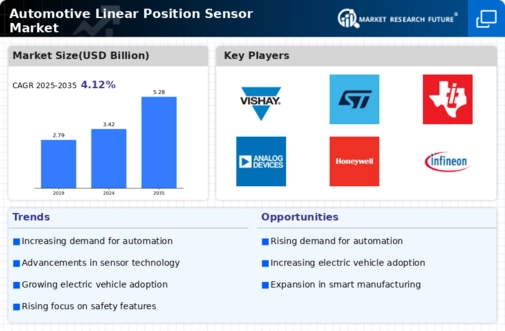Rise of Electric and Hybrid Vehicles
The surge in electric and hybrid vehicle production is a crucial driver for the Automotive Linear Position Sensor Market. As manufacturers pivot towards sustainable mobility solutions, the need for efficient and accurate position sensing in electric powertrains becomes increasingly vital. Automotive Linear Position Sensors play a critical role in battery management systems and electric motor control, ensuring optimal performance and energy efficiency. The electric vehicle market is anticipated to witness a substantial increase, with projections indicating that electric vehicles could account for 30% of total vehicle sales by 2030. This trend is likely to stimulate demand for Automotive Linear Position Sensors, thereby enhancing the market landscape.
Regulatory Compliance and Safety Standards
Regulatory compliance and safety standards are becoming increasingly stringent in the automotive sector, serving as a key driver for the Automotive Linear Position Sensor Market. Governments and regulatory bodies are implementing more rigorous safety protocols, necessitating the integration of advanced sensing technologies in vehicles. Automotive Linear Position Sensors are essential for meeting these safety requirements, particularly in systems that monitor critical vehicle functions. The market is likely to see a rise in demand as manufacturers strive to comply with evolving regulations, which may include enhanced testing and certification processes. This regulatory landscape is expected to propel the Automotive Linear Position Sensor Market forward.
Focus on Miniaturization and Enhanced Performance
The ongoing trend towards miniaturization and enhanced performance in automotive components is significantly influencing the Automotive Linear Position Sensor Market. As vehicles become more compact and technologically advanced, the demand for smaller, high-performance sensors is on the rise. Manufacturers are increasingly focusing on developing sensors that offer improved accuracy and reliability while occupying minimal space. This shift is particularly relevant in the context of modern vehicle designs, where space optimization is critical. The market for miniaturized sensors is expected to expand, with estimates suggesting a growth rate of around 8% annually. This trend is likely to drive innovation within the Automotive Linear Position Sensor Market.
Increasing Demand for Automation in Manufacturing
The increasing demand for automation in automotive manufacturing processes is a significant driver for the Automotive Linear Position Sensor Market. As manufacturers seek to enhance efficiency and reduce production costs, the adoption of automated systems becomes essential. Automotive Linear Position Sensors are integral to robotic systems and automated assembly lines, providing precise feedback for positioning and movement. The automation market in the automotive sector is projected to grow at a CAGR of approximately 9%, indicating a robust demand for position sensors. This trend underscores the importance of Automotive Linear Position Sensors in facilitating advanced manufacturing techniques.
Integration with Advanced Driver Assistance Systems (ADAS)
The integration of Automotive Linear Position Sensors into Advanced Driver Assistance Systems (ADAS) is a pivotal driver for the Automotive Linear Position Sensor Market. As vehicles increasingly adopt sophisticated safety features, the demand for precise position sensing becomes paramount. These sensors facilitate functionalities such as adaptive cruise control and lane-keeping assistance, enhancing overall vehicle safety. The market for ADAS is projected to grow significantly, with estimates suggesting a compound annual growth rate (CAGR) of over 10% in the coming years. This growth directly correlates with the rising need for reliable position sensors, thereby propelling the Automotive Linear Position Sensor Market forward.
















Leave a Comment